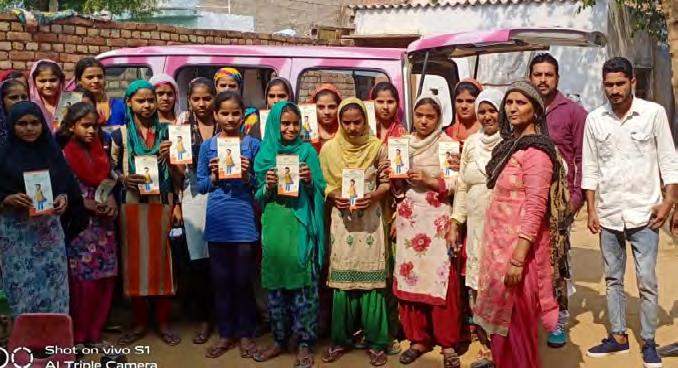
36 minute read
u adika ratna Sekhar
The joy of growing together
CSR and sustainability are seamlessly integrated with Balmer Lawrie’s overall ecosystem
Advertisement
The covid-19 pandemic triggered a monumental shift in the way businesses are operating today. There’s no doubt that most of us are walking a tightrope and will have to do so for some time. Uncertainty is here to stay, and is now compounded by the war in the Ukraine. In these unprecedented times, corporate Social responsibility (cSr) and Sustainability assumes great significance and meeting Sustainable Development Goals is absolutely non-negotiable.
Balmer Lawrie is a very diverse organisation, which has a strong presence in both the manufacturing and service sectors. This diversity has helped the company stay strong and profitable. Very interestingly, this element of diversity has permeated into the various facets of the organisation including cSr and Sustainability.
Balmer Lawrie’s cSr initiatives are driven by two flagship programmes – Balmer Lawrie Initiative for Self-Sustenance (BLISS) and Samaj mein Balmer Lawrie (SamBaL). While the first programme is directed at providing and improving the long-term economic sustenance of the underprivileged, the second programme aims at improving the living standards and quality of life of the population in and around the company’s work-centres pan India. The focus areas for the schemes under the programmes, amongst others, have been on education, healthcare, sanitation, and integrated village development and the target groups include children, women, young people, the elderly and differently abled people.
The company is a founding member of the UN Global compact in India and has also been publishing the Brr and sustainability report annually. Trust and transparency are keys to driving a culture of sustainable development and the company is committed in its journey to steer sustainable growth not only in its businesses processes, products and services but in the overall ecosystem comprising all its stakeholders and the community. a total sum of R514 lakh was spent during the year 2020-21, towards cSr. To fight covid-19, the public sector has done exemplary work, especially companies under the ministry of Petroleum and Natural Gas (moPNG), GoI. Omcs and steel-makers have added 10,500 oxygenated covid beds in the country. These two sectors together had supplied the major part of the national requirement of liquid medical oxygen on a daily basis. Each of the oil PSUs including Balmer Lawrie under the administrative control of moPNG set up Pressure Swing adsorption (PSa) Oxygen Plants at various hospitals in different states as per the directive of the health ministry. In the current financial year cSr activities of PSEs are more focused on oxygen plant installation, oxygen cylinders and oxygen concentrator distribution, vaccination drives, distribution of mask and sanitisers to communities and distribution of food items to migrants and underprivileged families
There is immense scope for improvement in the various cSr activities undertaken by the Public Sector Undertakings (PSUs). There is a need for dynamic collaboration of efforts, and the interests of multiple stakeholders and beneficiaries need to be assessed. additionally, the cSr initiatives of PSUs are aligned with the various initiatives of the Government and hence, companies have to be proactive in enhancing the transparency and credibility of the processes involved in the projects. Strict SLas related to the role of exter-
nal agencies in assisting the corporates with the planning and implementation of cSr activities are needed. auditing and assessment are key for the success and sustainability of projects. member companies have to find out ways and means to assist each other in realising the success of the various common projects. Balmer Lawrie has adopted two villages in Silvassa, Dadra Nagar and haveli and one village in Taloja near its manufacturing operations and runs a robust ‘capacity building project on health and hygiene’ in association with the local administration and the implementation partner. The collaborative power of PSUs, private companies and even mNcs is immense. Former Secretary-General of the United Nations, Ban Ki-moon said: “Sustainable development is the pathway to the future we want for all. It offers a framework to generate economic growth, achieve social justice, exercise environmental stewardship and strengthen governance.” collaboration is a must to protect the earth and its people. u
aDIK a r a TN a
S EK har
The author is chairman
& managing director, Balmer Lawrie & Co. Ltd
Health is wealth
Deep structural and sustained reforms are needed to strengthen the healthcare infrastructure
JINDAL STEEL & POWER
An express delivery
Through its healthcare activities, aligned with SDG-3, Jindal Steel & Power Ltd (JSPL) has been trying to improve the society’s access to quality and affordable healthcare facilities – both preventive and curative. The healthcare programmes, run by JSPL Foundation, ranges from providing health measures in rural areas through mobile medical units to institutionbased super specialty health services. It aims to lower IMR and MMR, combating child malnutrition, minimising anaemia in adolescent girls, creating open-defecation-free environment, operating telemedicine centres, combating HIV & AIDS and sustained healthcare for the differently-abled and establishing secondary and tertiary health services. The programmes are also aligned to the UN Sustainable Development Goals.
Kishori Express, an anaemia control programme meant for adolescent girls, is implemented across 528 villages of Banarpal, Chendipada and Angul blocks in Angul district of Odisha and 87 villages of Punhana block of Nuh district of Haryana. The programme was launched in April 2011 in Chendipada block and replicated at Banarpal block in 2012 and, later, in Angul block in 2018. It’s now operational in Nuh, Haryana too, covering Punhana block under the aspirational district programme of the government.
The vehicle, branded Kishori Express, is equipped with a touch screen computer, in which a quiz is conducted to create awareness among adolescent girls. It also has facilities like blood analysers, micro-cuvettes, swabs, seed kits, IFA tablets, sanitary pads, etc. It is staffed with counsellors, paramedics and computer operators too.
The team members counsel adolescent girls on health, nutrition and menstrual hygiene. Also, a haemoglobin test is carried out to check their HB percentage in blood. After the tests, the report is shared with the Health Department and ICDS for further follow-up. Girls in ‘severe condition’ category are advised to take high nutritional support to improve their HB level. Kishori Express also provides a seed kit – a pack of seeds of vegetables, which are rich in iron. The girls are encouraged to plant these seeds in their backyards for future consuming. The anaemic cases are referred to anganwadi centres, where they are given tablets.
The implementation process The project is being implemented by JSPL, in collaboration with the district administration, health department and ICDS. Dedicated teams from JSPL, with customised vehicles, are in the field for the implementation of the project.
The project implementation process involves a monthly micro plan, prepared in consultation with the government stakeholders; reaching out to the adolescent girls and sensitising them on health & hygiene; and sharing of reports with stakeholders.
At Nuh, Haryana, in one year after implementation, the project had helped and guided more than 22,000 adolescent girls. At Angul, the project covered 528 villages, attending to the needs of 2.28 lakh adolescent girls. There has been a 91 per cent reduction in severe-to-moderate anaemic cases and 93 per cent reduction in moderate-to-normal cases since the project started its operations in 2011-12 at Angul.
ASHA (hope) is a programme mainstreaming the differently challenged children, having multiple special needs through care, support and rehabilitation. It has been providing stateof-the-art rehabilitation services and vocational training, through its centres in Raigarh, Angul and Patratu. ASHA was established in August 2009, to give special education and therapeutic services to the special children living in the periphery of villages, so as to bring them into mainstream. The facilities offered cover rehabilitation
Kishori Express beneficiaries at Nuh
services in daycare mode to nearly 130 children with disabilities regularly. They are also provided transportation facility from their respective homes to the centre and back.
Since inception, nearly 5,004 children have been provided with various rehabilitation services such as physiotherapy for mobility improvement; training to mentally retarded children, for cognitive, social and psychological development; training for speech and hearing impaired children; training to teach them skills to make them self-reliant; and appliances like prosthetic limbs, customised wheelchairs, hearing aids, calipers, etc.
The journey that started 11 years ago has had its share of barriers. A superstition that disability is a consequence of the deeds done in previous lives was prevalent. And the family expected the child to be magically healed in a short span of time. Parents’ counselling sessions helped to remove much of the myths that were fogging their minds.
ASHA has also taken measures to engage the villagers in sustainable livelihood programmes. It provides training to the differently-abled in selected trades too. Its centre has invariably lived up to the expectations.
Today, the villagers come forward to get the differently-abled treated. Earlier, the aids and appliances provided by the NGOs were not customised to meet the individuals’ needs; hence, they were of little use. Provisioning of customised appliances by ASHA centres has led to their continuous use.
As a result of the awareness and sensitisation programmes by the members of the academia, the schools for normal children have started to open up their doors for the differentlyabled too. u
MINDTREE FOUNDATION
Health, hygiene and dignity
The vast majority of menstruating women in India face many social and economic challenges. Extreme poverty and gender disparity exacerbate this problem. Menstruation is treated as a taboo in much of India, further risking the health and wellbeing of women.
The Mindtree Foundation collaborated with Goonj for a programme that involved working with Kui tribal women to help them understand the importance of physical and menstrual health and hygiene. The team makes ‘MY Pad’ kits of sanitary pads from surplus cotton cloth collected in cities and distributes these kits free of cost to the tribal women.
Each pack of Goonj’s MY Pad clean cloth sanitary pads contains eight ‘MY Pads’ with three pad covers, one undergarment, an information leaflet, a waterproof pouch (made from used flex, based on availability) for a woman to carry her pad for washing and reuse, one set of women’s clothing/woollens or aasan (sitting mat)/dari, toiletries/ medical kits and other items of daily utility and Goonj ka Jhola (Goonj’s handmade, eco-friendly cloth bags).
Through the #NotJustAPieceOfCloth programme, Mindtree supports 2,500 women and adolescent girls, discouraging them from using sand, ash, rags or cow dung during menstruation, and ensuring better health and hygiene. They also involve these tribal women in finding relevant circumstantial solutions to their problems, train them in specific skills, and help them earn a livelihood with dignity.
Community-level meetings The Mindtree Foundation has been driving the collection of surplus cloth year on year, collecting and sending old clothes to Goonj every month for making sanitary pads. To help these women open up on the subject of menstruation, community-level meetings and exhibitions on menstrual hygiene are conducted. In the interest of their health and hygiene, they are also encouraged to prepare nutritious food, set up kitchen gardens, make private spaces for bathing, clean water bodies, and so on.
When Reshma started menstruating at the age of 17, she would go to the well for a bath during her menstrual cycle. It was an open well without a boundary wall. As some young boys would also play near the well, she could not maintain personal hygiene and returned home feeling disappointed. She avoided going to the well for a bath for the next three days. After the awareness session, the villagers decided to build a bathroom around the well. This was well-received by the women, who could now maintain cleanliness and personal hygiene.
The Mindtree Foundation has been supporting this project for the last two years, benefiting more than
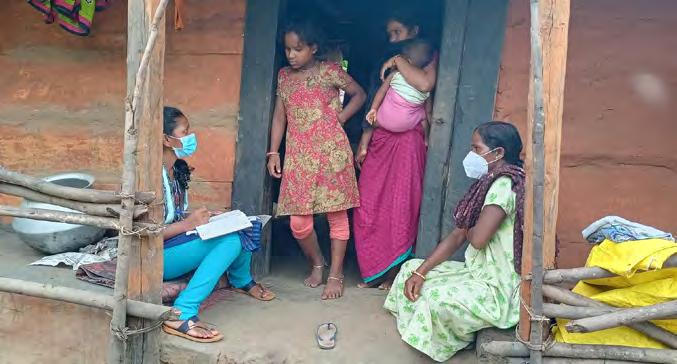
Mindtree supports the awareness campaign of personal hygiene among the Kui tribal women
ONGC
A health pipeline
The tiny town of Sibsagar in Upper Assam is blessed with tremendous natural resources and has a rich history. However, this historic town lacked basic medical facilities. ONGC has been operating in Sibsagar for the last six decades and was aware of the challenges.
In 2016, ONGC engaged PwC to carry out a need assessment study to understand the actual medical requirement of the region. The results were alarming; Sibsagar had 0.52 hospital beds per 1,000 people, less than half of the India average of 1.1 beds per 1,000. A majority of the patients had to travel either to Dibrugarh or Guwahati for secondary care treatment and people were travelling outside Assam for tertiary treatment.
Based on the findings of PwC, ONGC collaborated with Dr Babasaheb Ambedkar Vaidakiya Pratisthan (BAVP) for construction, operation and management of a 300-bed multispecialty hospital with the objectives of providing quality healthcare facilities to all sections of society at an affordable cost, reducing the hospital bed deficit in Upper Assam and providing tertiary care treatment locally. It is being implemented in three phases at a cost of R313 crore. BAVP is a not-for-profit organisation and has around 30 years of experience in providing quality healthcare at affordable cost to all sections of community. The Siu-Ka-Pha Multi Specialty Hospital was thus set up, named after the first Ahom King of Assam. Even for a simple dialysis, people of Sibsagar used to travel to Dibrugarh three days a week, which was more than 90 km away. To address this critical issue of dialysis and other basic medical facilities, ONGC decided to start the first phase of the hospital before the scheduled timeline with 67 beds including eight dialysis beds, which has resulted in delivering affordable healthcare to the people. Further, the treatment is being provided at 70 per cent of the market cost, which ensures a steady inflow of OPD patients. In the last twoand-a-half years, more than 4,600 OPD patients have been served and 12,000plus dialyses have been performed, which has ultimately ensured the sustainability of the hospital.
Passing on the benefits The OPD fee at the Siu-Ka-Pha Hospital is R150 which is less than one-third of other similar hospitals charge in the area. The net benefit/savings passed on to patients in the last two years only through OPD was R14.02 crore. Similarly, the cost of a single dialysis at a hospital in Dibrugarh was twice that of the Siu-Ka-Pha hospital. Accordingly, benefits worth R2.33 crore have been passed on to patients.
Affiliating the hospital with Ayushman Bharat and Atal Amrit schemes of the Government of India has ensured a regular inflow of patients which has resulted in initial sustainable operations of the hospital. Since, the hospital runs on a not-for-profit model with capital infrastructure coming up from ONGC CSR funding and the majority of the staff engaged from local areas, the cost towards recurring expenditure was minimal. The income generated from quality OPD, IPD, surgeries, pharmacy, diagnostic treatment, and pathology services, ensures the sustainability of the hospital. In the last two years, more than 45,984 OPD patients have used the services of the hospital. As much as 12,135 dialyses have been performed. The hospital has ICU beds, special wards and general wards and is equipped with basic diagnostic facilities. Dialysis patients who earlier used to visit Dibrugarh, three days a week are now using the services near their home which has ensured more than 60 per cent savings. Other services are being provided at 75 per cent of the market cost ensuring quality treatment even for people from the economically weaker section of society. Moreover, the hospital is registered under the Government scheme of Atal Amrit and Ayushman Bharat, which has benefited large number of underprivileged families
During the Covid-19 pandemic outbreak in 2020, as an emergency measure, a 20-bed Covid-Care centre was set up and subsequently, during the second wave of the pandemic in 2021, another 40-bed fully equipped inflated Covid ward with oxygen facilities was set up in record time. Till December 2021, more than 620 Covid patients were provided treatment.
Once the third phase of the hospital is commissioned, more than a lakh of patient will be benefited every year. The Siu-Ka-Pha Multispecialty Hospital is significantly contributing towards achieving the objective of SDG-3.
The Siu-ka-Pha hospital currently has 67 beds. A total of 162 more beds will be added in 2022 and another 100 beds are planned to be commissioned in phase three. By 2025, more than one lakh patients will be using the services of the hospital every year. u
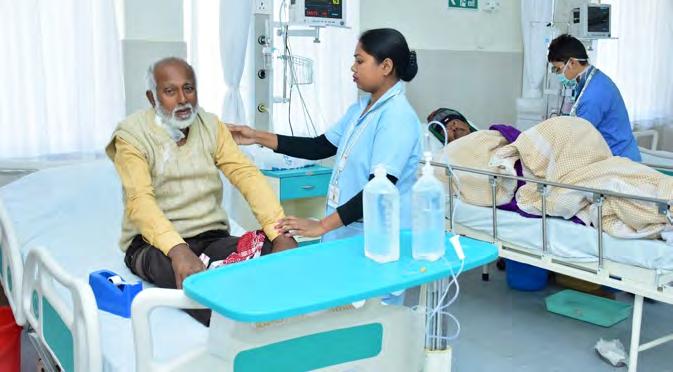
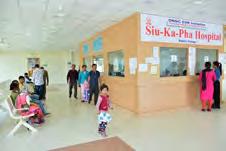
A patient is being treated at ONGC’s Siu-Ka-Pha Multi-specialty hospital
HITACHI INDIA
Upskill and reskill
At the point when the Covid-19 pandemic struck the world in 2020, there was much apprehension in terms of how India would address a crisis of this magnitude. One of the critical areas that needed immediate attention was the human capacity constraint amongst India’s healthcare workforce.
According to an NSSO survey (2019), India had 20.6 healthcare workers for every 10,000 members of the population, as compared to a minimum threshold of 22.8 specialists suggested by the WHO. Moreover, as more healthcare workers could contract the virus, it would have placed further pressure on our health systems. Therefore, given their vulnerabilities, supporting healthcare workers in their capability to respond to the pandemic became fundamental.
To help in relieving and supporting healthcare workers in mitigating this threat, Hitachi India undertook an ambitious initiative entitled ‘Covid19 Skill Enhancement Programme’ (CSEP) during December 2020-March 2021, to upskill and reskill 4,000 Covid-19 care-givers (doctors and nurses) across Maharashtra, Delhi and Karnataka. The programme contributed towards target 3.c of UN’s SDG framework – “substantially increase health financing and the recruitment, development, training and retention of the health workforce in developing countries, especially in the least developed countries and small island developing states”.
The objectives of the programme were three-fold: imparting essential training rapidly to the Covid-19 caregivers (doctors and nurses), as well as other medical and nursing professionals serving in non-Covid hospitals; bringing standardisation to the patient care delivery across the nation; and reducing the need for daily repeated training for new batches and save significant time for hospital administration and clinicians.
To deliver the programme viably, Hitachi India collaborated with PlexusMD, a leading learning and career development platform for doctors and medical staff. The course endeavoured to build capacity in critical areas, such as appropriate utilisation of PPEs, contamination counteraction, isolation, quarantine and treatment protocols, management of biomedical waste and managing mental health among other aspects.
The programme was delivered on Medcast, an e-learning platform developed by PlexusMD and consisted of 12 pre-recorded sessions that were specially curated for doctors and nurses. Each session was followed by a selfassessment for evaluating the viability and achievement of learning outcomes.
This online training programme for Covid-19 was co-designed with Hitachi’s inputs, considering the evolving necessities of the healthcare staff at the forefront, as well as aligning to pertinent guidelines issued by the ICMR (Indian Council of Medical Research) and MoHFW (Ministry of Health and Family Welfare), among others. As a result, the programme was certified by the Association of Physicians of India (API) and was recognised under their Continuing Medical Education (CME) requirements for ongoing training and upskilling. Additionally, in terms of outreach, various medical associations, such as Karnataka Medical Council and the respective state governments also partnered in the endeavour.
The entire programme received positive response from doctors and nurses alike, who observed the course content significant and timely, delivered in an engaging manner. The course set a broader context around dealing with infectious diseases generally, which will have relevance even as Covid-19 becomes endemic in the coming months. The lessons, conventions and protocols discussed in the course were practically applied by the doctors and nurses.
This initiative is an illustrious testimony of how best CSRs can collaborate with social enterprises to achieve transformative change, crossing the compliance hurdle. Hitachi, through such initiatives, is helping build a healthy, prosperous society and contributing towards India’s healthcare system, by ensuring that each citizen can access quality healthcare. u

Hitachi India’s skill enhancement programme
GIVAUDAN INDIA
Lead kindly light!
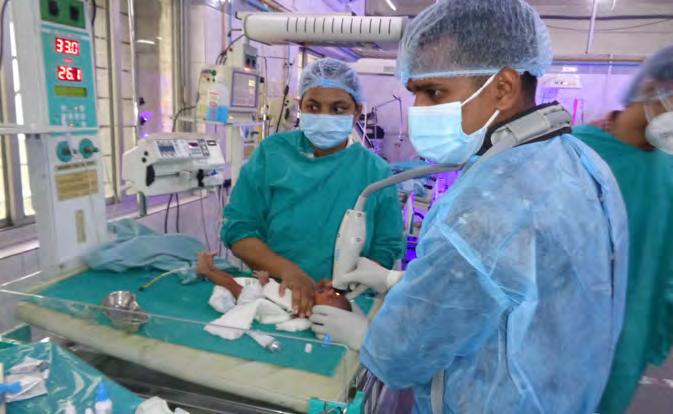
Givaudan’s project saves children suffering from Retinopathy of Prematurity
The purpose of Givaudan India, a consumer services company, is to drive sustainable, long-term performance, while leading the way to improve happiness and health for people and for nature. As part of this, it has been challenging itself to have a positive impact on communities, particularly when it comes to delivering on its ambition that, by 2030, it would have improved the lives of millions of people in communities, where it sources and operates.
The company has been creating accessibility for little known but necessary services for premature babies, as also building a diverse portfolio of projects for different beneficiaries across the sites. Since 2011, it has been on a journey, impacting more than 500,000 individuals in different ways. Today, across four locations, Givaudan India has 11 projects in nutrition, blindness and water & environment.
Givaudan’s products are ingredients utilised in nutrition, fragrance and beauty for other manufacturing companies. It has focussed primarily on community projects, which address nutrition and vision. In the area of eye health, Retinopathy of Prematurity (RoP) has been its flagship project, initiated in Jigani, Bengaluru in 2011. Today, the project has been scaled to two additional locations in Maharashtra – Ahmednagar (near the manufacturing unit in Ranjangaon) and Mumbai (head office).
RoP is a disorder, which usually develops in both eyes, and is one of the most common causes of visual loss in childhood, leading to lifelong vision impairment and blindness. It is observed in pre-term babies weighing about 1,250 grams or less, born before 31 weeks of gestation. An increasing number of pre-term babies survive due to improved access to facility based neo-natal care, ironically they are at risk of developing RoP. During the neonatal period, RoP is a silent disease and active screening by retinal examination is needed for detecting its presence, severity and need of treatment.
In 2011, Givaudan kicked off the project by supporting the treatments (lasers and injections) needed for the babies diagnosed with the condition. At that time, the outreach by the implementing agencies was limited to few neonatal ICUs (NICUs) in the city. From 2011 to 2017, as many as 122 babies were saved from becoming permanently blind.
Preventing blindness By 2018, a fiveyear plan was made to cover all NICUs and other units, where premature babies are cared for and treated (as needed) in 12 districts progressively in Karnataka. The programme expanded to four times its size in this time. Alongside this, the relevant medical personnel from the units identified were trained to diagnose the condition and treat the babies too. In 2018, a second chapter was launched in Ahmednagar. Here, workshops and on-the-job training were combined to build capacities and increase the pool of experts. In 2019, it was decided that a third chapter would be initiated in Mumbai and Navi Mumbai.
Since 2011, a total of 438 babies have been prevented from going permanently blind, after screening 4,578 babies multiple times to identify those at risk of developing the condition. Post-treatment, the screenings continue to ensure that there are no other visual ailments are developing.
Born premature at 28 weeks, weighing only 1,080 gm and having spent a month in the NICU, Baby BD was referred for an RoP screening. It was found to be RoP positive and needed urgent vitrectomy surgery for both eyes. Facing various challenges – finding a specialised hospital to operate on a low weight baby, as also financial challenges – Baby BD was referred to the Givaudan’s RoP programme for the surgery. He was operated free of cost at 1.5 months. At 2.5 years today, he has perfect vision.
Screening, testing, diagnosis, treatment and follow-ups are at the forefront of the project. Givaudan India has so far invested more than R2.79 crore, covering extra equipment, vehicles and salaries across three locations. The company will invest another R1 crore between now and 2023 to complete screening of at least 1,000 babies with 150 surgeries.
Since its initiation, the project has been contributing to SDG-3 (good health and wellbeing). Contribution to this SDG in the project is not just about the babies only; it also promotes and supports the physical, emotional and mental wellbeing of the family.
Givaudan believes in the power of collaboration to drive change. Therefore, along with its partners, the company is preparing a white paper to invite other agencies to work together to tackle this health issue. “Working in the area of RoP is unique, as we are able to identify the affliction in the babies at an early stage and ensure a timely surgical intervention, which improves their quality of life forever,” says Shanmugam Karthikeyan, director, Givaudan India. “This is the biggest way we can ensure that these children will have a strong start to a happy and healthy life.” u


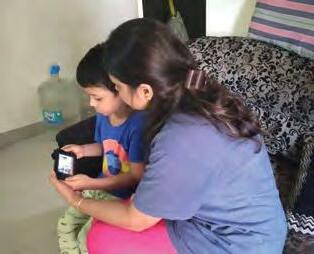
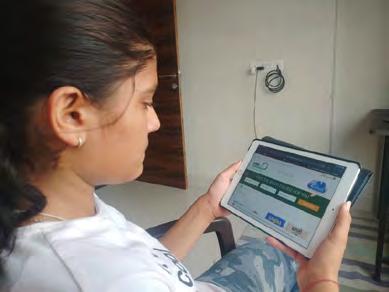
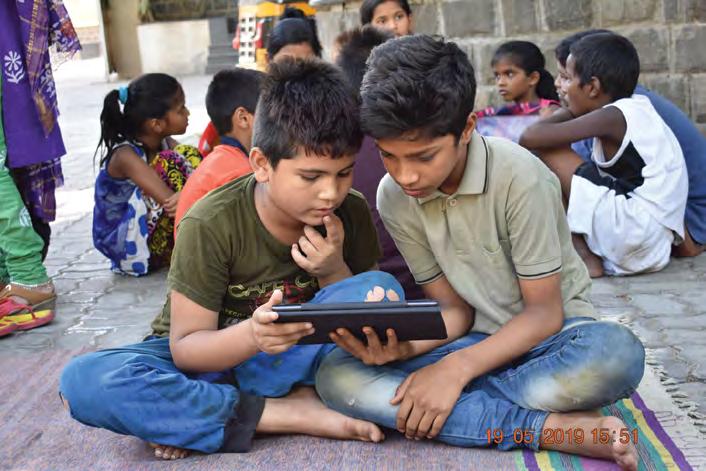
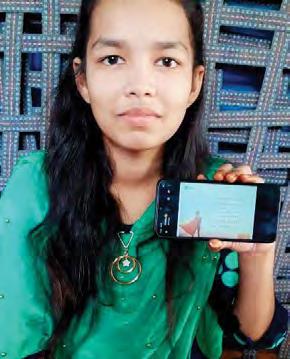

Ensure inclusive and equitable quality education and promote lifelong learning opportunities for all
Before Covid-19
Progress towards inclusive and equitable quality education was too slow
Inequalities in education are exacerbated by COVID-19
In low-income countries, children's school completion rate is
Over 200 million children will still be out of school in 2030
Covid-19 Implications
School closures kept 90% of all students out of school reversing years of progress on education
79% in richest 34% in pOOREST 20% of households 20% of households
Remote learning remains out of reach for
at least 500 million students
Only 65% of primary schools have basic handwashing facilities critical for COVID-19 prevention
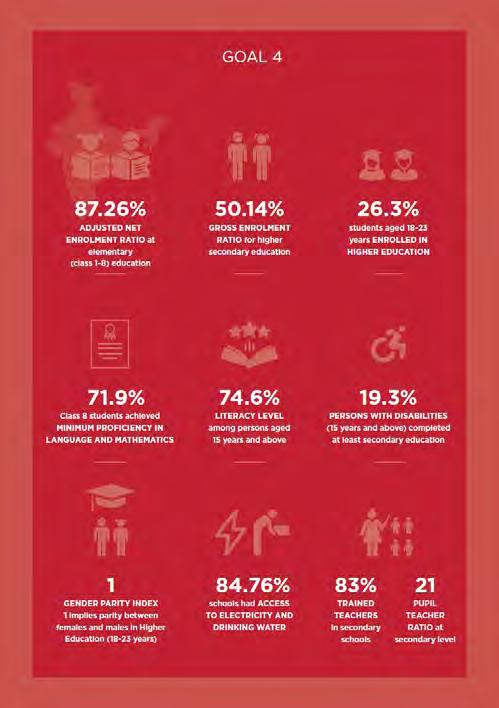

Education is one of the top SDGs across countries and is considered one of India’s most important. However, despite these factors, India’s quality of education has seen a consistent decline in recent years. As per the UN’s most recent rankings, India ranks 97th in the world for quality edu‑ cation, with a score of 86.48, making it evident that signifi‑ cant challenges remain. Based on goals set at the 2015 Conference of Parties, India’s targets in this space for 2030 have been formulated as follows: 4.1 Ensure that all girls and boys complete free, equitable and quality primary and secondary education leading to relevant and effective learning outcomes 4.2 Ensure that all girls and boys have access to quality early childhood development, care and pre‑primary education so that they are ready for primary education 4.3 Ensure equal access for all women and men to afford‑ able and quality technical, vocational, and tertiary education, including university 4.4 Substantially increase the number of youth and adults who have relevant skills, including technical and vocational skills, for employment, decent jobs, and entrepreneurship 4.5 Eliminate gender disparities in education and ensure equal access to all levels of education and vocational training for the vulnerable, including persons with disabilities, indige‑ nous people, and children in vulnerable situations 4.6 Ensure that all youth and a substantial proportion of adults, both men and women, achieve literacy and numeracy 4.7 Ensure that all learners acquire the knowledge and skills needed to promote sustainable development, including, among others, through education for sustainable develop‑ ment and sustainable lifestyles, human rights, gender equal‑ ity, promotion of a culture of peace and non‑violence, global citizenship and appreciation of cultural diversity, and of cul‑ ture’s contribution to sustainable development
At the national level, India’s budget for Education has seen a consistent rise on the surface, increasing from R63,000 crores in 2011 to R99,000 crores in 2020. While this appears promis‑ ing, the percentage of the national budget allocated for Educa‑ tion over the same period has seen a substantial decline from 5 per cent to 3.26 per cent. This decline is especially problem‑ atic due to the consistent rise in population across the coun‑ try, and could prove challenging in the nation’s attempts to bridge literacy gaps and increase education rates.
Despite a decline in funding for Education and the declining trend identified by the UN, literacy rates have shown a gradual increase in India across the last three decades. In 1981, India’s literacy rates stood at 40 per cent compared to the global average of ~70 per cent. It has since increased to 74.37 per cent, trailing the global average by 11.88 per cent. This consistent increase in literacy across the nation can be attributed to national programmes and corporate efforts to increase the overall enrollment in edu‑ cational institutions.
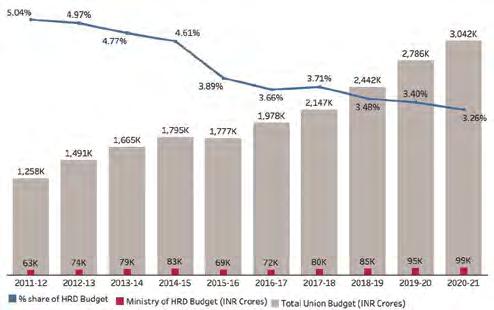
Enrolments from Pre-primary to higher education levels
One of India’s goals is to ensure that all girls and boys have access to high-quality early childhood development through pre-primary education so that they are ready for primary education. Since 2012, enrollments in pre-primary schools have increased by 70 per cent, with the total number of students increasing from 79.88 lakhs to 1.36 crores, despite a decline between 2016 and 2018. These educational programmes have been run by Anganwadis and have helped provide early access to education to children between 3 and 6 years of age. Across higher education levels, similar changes are prevalent. Among Higher Secondary (Grade XI-XII), enrolments rates have increased from 24.95 to 32.30 per cent between 2012 and 2020. Secondary (Grade IX-X) enrollment saw the steepest increase between 2012 and 2018, from 50.53 per cent to 62.24 per cent. However, a steep decline in 2019 meant enrollment rates had dropped to 57.59 per cent, which despite changes, remains to be a considerable improvement from 2012.
Primary and Upper Primary have also shown slightly erratic growth, with both seeing significant declines in 2018. In the last eight years, Primary (Grade I-V) enrollments dropped from 98.9 to 94.26 per cent in 2018, only to recover in 2020 to 97.31 per cent. Upper Primary enrollment rates increased from 72.13 per cent to 79.55 per cent in 2020, with a drop

of 2.22 per cent in 2019, resulting in a positive increase overall. While the net enrolment rates have been improving, Higher Secondary enrolment rates are meagre, at nearly half that of Secondary rates (59.98 per cent), showing there is still tremendous room for improvement.
These trends of declining enrollment are reflected in the drop-out rates between 2013 and 2020. While the drop-out rates at Primary level are very low, they are significantly higher at the Secondary levels, racing up to 21.49 per cent in 2016-17. Based on these rates, in 2020, it can be estimated that 1 in every 6 pupils enrolled at the Secondary level dropped out.
For students enrolled in Higher Education (between the ages of 18-23 years), there has been a steady increase in the Gross Enrollment Ratio (GER) over the last decade. While the year-on-year growth has been consistent, what stands out is the rate at which the GER of females in higher education has increased significantly. By 2019, the gap between male and female enrollment had closed, with female enrollment surpassing males in 2020. Also notable is that between 2010 and 2020, female GER has increased from 18 per cent to nearly 28 per cent, while during the same period, male GER has increased from 21 per cent to 27 per cent.
Contributing factor
Various factors can contribute towards students’ enrollment in schools, and the pupil-to-teacher ratio is a contributing factor. As per India’s National Education Policy, the idea pupil-to-teacher ratio is 1:25 or less. As per 2019-2020 data, for Primary schools, 13 states had a pupil-toteacher ratio that exceeds the standard, with Bihar having an average of 56 students per teacher, followed by Delhi, Jharkhand, and Uttar Pradesh having a ratio of 33, 31 and 31 respectively. A similar trend is seen in Upper Primary, where the ratio for Delhi, West Bengal, and Maharashtra are very high, at 30, 28, and 27 respectively. This could be a result of the increased population seen in these states or possibly due to poor funding. Learning Outcome Scores have helped identify the progress being made in schools. They are tracked as a part of the Performance Grade Index (PGI) score that is calculated as the average score in four subjects – Language, Mathematics, Science, and Social Science, with a maximum score of 80. In 2019-20, Rajasthan, Jharkhand, Chandigarh, Gujarat, and Karnataka had the highest PGI scores for grade VIII. This data corroborates the importance of the pupil-to-teacher ratio which was relatively good in all these states.
Basic infrastructure is another significant contributor which affects students’ continued enrolment. Four key areas have been tracked in terms of basic Infrastructure at schools in India. These include essential facilities such as functional drinking water, functional toilets and sinks for handwash and accessibility such as ramps and handrails, which make classrooms easier to access. In 2019-20, it was found that 90 per cent of schools across India have essential facilities, 67 per cent had ramps, and only 43 per cent were found to have handrails.
Other vital facilities that affect both enrollment and learning in schools are the digital facilities such as functional electricity, computers and internet connectivity, and facilities for intellectual and physical growth such as a playground and library. Reports from the Department of School Education and Literacy show that 84 per cent of schools had libraries and 75 per cent had playgrounds, both of which were a 10 per cent increase since 2013. In addition, digital facilities have seen significant improvement since 2013. In 2020, 80 per cent of schools had usable electricity as opposed to 53 per cent in 2013. Similarly, computer access increased from 24 per cent to 38.5 per cent, and internet access increased from 7 per cent to 22 per cent over the same duration.
CorPoratE Contribution
While government funding for Education hasn’t seen a significant increase in proportion to the increase in student population, the sector has been garnering significant attention from corporates. Since 2014, the Education sector has consistently remained a top priority and has received 31 per cent of the total CSR spend (R28,754 crores), which was directed not only towards education programmes but also towards special education. The top five corporate contributors in this space include Reliance Industries, Wipro, NTPC, Mahanadi Coalfields, and TCS. 43 per cent of this money was contributed between 2018 and 2020. Maharashtra tops the states with CSR receipts at R5409 crores, which nearly equal the amount invested in the next four states – Karnataka, Tamil Nadu, Gujarat, and Delhi.
These efforts are helping improve education in several parts of India. With sustained efforts, we can hope that the face of education in India will continue to improve, at least in quantitative terms. A lot of research and analysis is underway to analyse the qualitative levels of Education across levels. The National Education Policy 2020 has given guidelines and timelines for various aspects that would improve quality along with the GER pan-India.
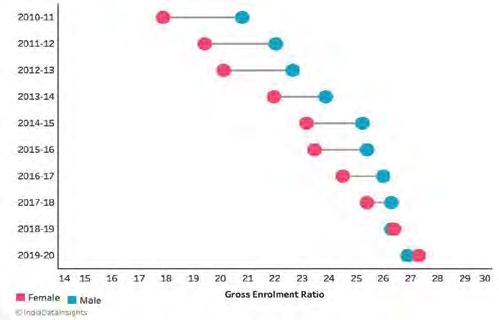
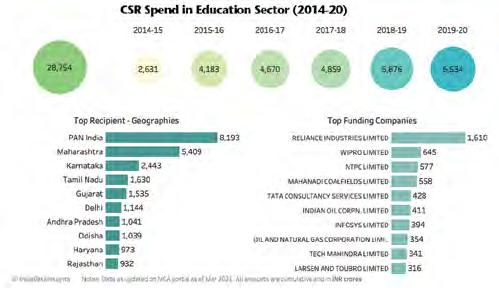







Automobile industry PAving WAy for sustAinAble mobility
global automakers bring sustainable transformation to reduce carbon footprint to counter rising global warming.
Zero emission vehicles and carbon neutral manufacturing have been growing significantly in the automobile industry. With stricter emission norms and increasing awareness towards environment, auto makers as well as customers have started shifting towards sustainable mobility. The transformation has brought radical change in the means of connected cars, electric vehicles, shared mobility, and autonomous vehicles.
Few manufacturers have already started taking steps towards contributing their share with more environment friendly mobility options. With introduction of various techniques, manufacturers have managed to reduce carbon emission even during vehicle production. The inclusion of advanced technology and the rising production of electric vehicles has completely changed traditional methods of car production.
MG Motor India has recently launched the all-new ZS EV which comes with the largest in-segment 50.3 kWh battery, offering a 461 km certified range in a single charge. The all-new ZS EV has been restyled with striking exterior design elements, comfortable and premium interior, firstin-segment features like Dual Pane Panoramic Skyroof, Digital Bluetooth® Key, Rear Drive Assist, 360° Camera, iSMART with 75+ Connected Car features, Hill Descent Control and much more. It also packs a globally certified (ASIL-D, IP69K and UL2580) battery that has passed 8 special safety tests, including fire, collision, dust, smoke, etc.
MG Motor India has taken significant steps to build a sustainable future not just by manufacturing electric vehicles but also by adopting multiple other green initiatives to steer this conversation forward.
ev bAttery recycling, mAking electric mobility greener
MG Motor’s 360-degree approach to sustainability has empowered the company to go above and beyond. The company has been at the forefront of promoting EV adoption; recycling batteries and launching modern EVs for its customers.
MG Motor India, in partnership with Attero, is on a mission to create a circular and sustainable EV economy in India. In doing so, they have successfully recycled MG’s first EV battery and the metal extracts and various other commodities from the recycling process can be used to develop new batteries.


Nitin Gupta, CEO and Co-founder – Attero Recycling said, “As the momentum of EV players grows, it is becoming critical for India to have a sustainable approach to managing E-waste. It also holds the key to helping our country transition from a linear to a circular economy. We have the technology that enables us to extract almost 99 per cent of all metals from a lithium-ion battery and we envision making India Atmanirbhar in precious metals such as Copper, Lithium and Cobalt through these processes. We are delighted to join hands with MG and our partnership will be instrumental in strengthening the EV ecosystem and set an example across the industry.”
AdoPting Wind solAr Hybrid energy
MG has also collaborated with CleanMax to emerge as the first passenger car manufacturer to adopt wind-solar hybrid energy. As a part of the partnership, MG’s Halol manufacturing hub will use 4.85 MW of wind-solar power supplied by CleanMax to conduct its operations, eliminating the use of 2 lakh Million Tonnes of carbon dioxide in 15 years which is equivalent to planting more than 13 lakh trees. MG Motor has also announced its latest initiative (Enviro Wash) to promote dry car washing, encouraging people to save up to 14 lakh litres of water per month per car.
Kuldeep Jain, Founder and MD of CleanMax said, “We are honoured that MG Motor India has chosen CleanMax as its sustainability partner. By supplying 50% of its power requirement from our Hybrid farm, MG Motor India will see significant operating cost savings, while also making a very impressive reduction in their CO2 emissions. We will also provide cost benefits to offer a hassle-free solution to the carmaker. Unlike standalone Solar or Wind power, Wind Solar Hybrid Power provides round the clock power supply, enabling consumers to meet a greater percentage of their daily power needs with renewable energy.”
furtHer strengtHening on energy conservAtion And sustAinAbility
MG Motor India took yet another step towards sustainability. The company recently became the world’s first automotive brand to use ULTRAX Degreaser, a liquid alkaline degreasing cleaner developed by PPG Asian Paints. The degreasing pre-treatment chemical launch aligns with the brand’s focus on making sustainable mobility greener, leading to a CO2 reduction of 787 tons/annum.
Apart from the ULTRAX degreaser, MG Motor India conserves energy through Low-Temperature Phosphate (VERSABOND) and High Throw Low Cure Cathodic Electro Coating Paint, leading to a CO2 reduction of 325 tons/ annum and approximately 388 tons/annum, respectively. These new technologies will support the company to enable a cumulative CO2 reduction of 1500 tons/annum.
MG Motor has always been vocal about creating a sustainable automotive industry in India. The company has recently acquired ISO certification on Environment Management System (ISO 14001 – 2015) and Occupational, Health & Safety Management System (ISO 45001 – 2018). Furthermore, MG is also working towards instilling a carbon-neutral and net-zero emission approach in its operations.
Apart from the ISO certifications, MG Motor has already implemented a few other sus-
Zs electric veHicle sAved 70 lAc kg of co2 in 2 yeArs* *equivalent to planting 42000 trees
tainable initiatives, including planting more than 7000 trees and adding 12 rainwater recharge wells to improve the groundwater level. MG has also worked on increasing energy productivity through Energy Committee and becoming a zero-waste landfill site. Furthermore, the MGI plant has been de-notified by State Government from MAH (Major Accident Hazard unit) to the non-MAH unit by eliminating the major hazard installation of 92 MT LPG and 22 MT LNG storage from premises.
MG Motor has also announced its latest initiative (Enviro Wash) to promote dry car washing, encouraging people to save up to 14 lakh litres of water per month per car. The company thrives on making sustainable mobility greener and intends to roll out other sustainable initiatives in the future. n


Ensuring end-to-end sustainability for electric vehicles is something we are passionate about at MG. Since battery waste is a challenge for sustainable mobility, we believe battery recycling is the optimum way of bridging this void. We look forward to doing more work in this space to create sustainable, end-to-end solutions that will help us drive radical impact.







